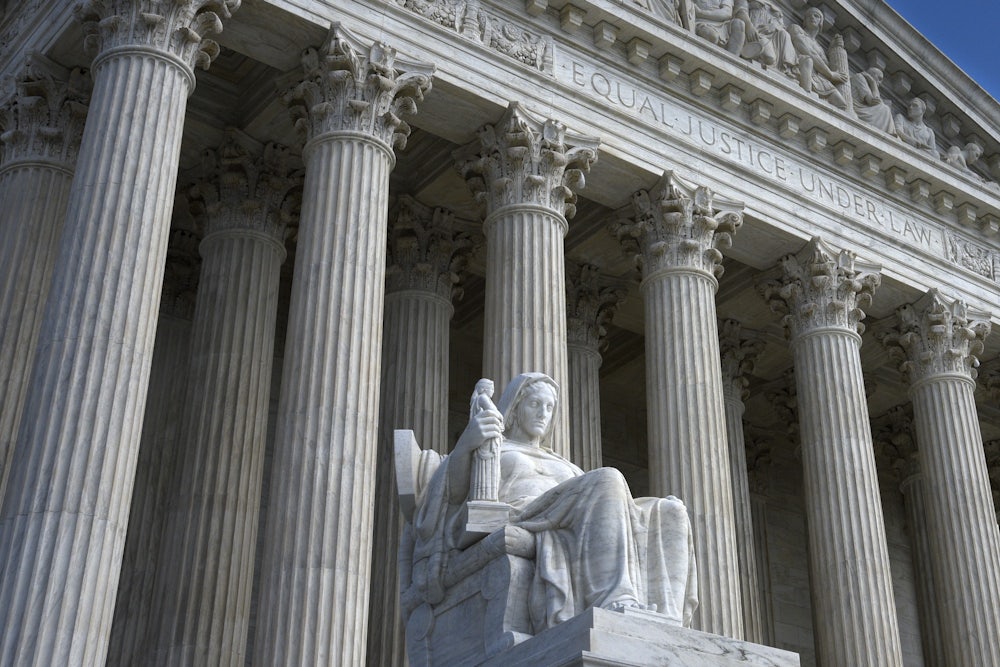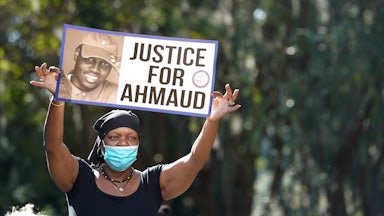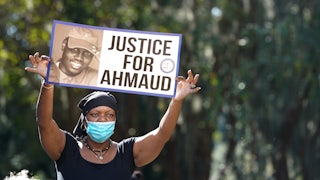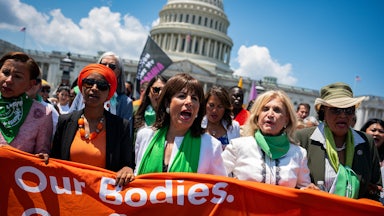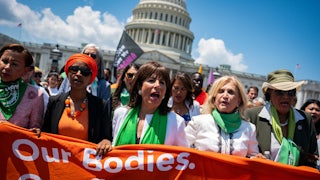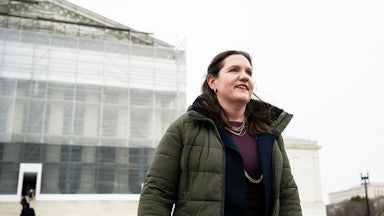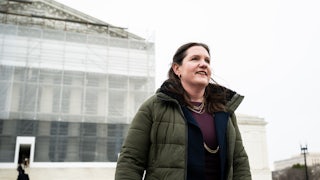Last term, the Supreme Court handed the conservative legal movement a victory it had sought for almost 50 years: the overturning of Roe v. Wade. As the justices reconvene this week for the new term, two sets of cases will give the court’s six-justice conservative majority a chance to revisit yet another hot-button issue: race. Both cases address it in the context of major institutions in American civic life. In Merrill v. Milligan, the justices will have the opportunity to place new limits on when and how voters can bring claims of racial gerrymandering before the federal courts. In SFFA v. Harvard University and SFFA v. University of North Carolina, they will get a chance to overturn precedents that allow race to be considered during the college admissions process.
At first glance, these two disputes aren’t as headline-grabbing as some of the more momentous cases from last term, which touched on abortion rights and the Second Amendment. And they don’t carry the same potential for dramatic outcomes as the high court’s upcoming case on the independent state legislature theory. But if the court’s conservative majority stays true to its recent precedent-overturning form, there could soon be major changes coming to the way that courts interpret—and Americans rely upon—the Fourteenth Amendment’s Equal Protection Clause.
Both of the affirmative-action cases came from a group called Students for Fair Admissions. The group was founded by Ed Blum, a white conservative legal activist who has organized past challenges to affirmative-action policies in higher ed and to the protections of the Voting Rights Act of 1965. SFFA told the court that it is “dedicated to defending the right to racial equality in college admissions” and that its members include Asian American students who say they were wrongfully denied admission to Harvard or UNC.
At issue is whether Grutter v. Bollinger, a 2003 ruling that allowed colleges to consider race in the application process, should be overturned. The Grutter court concluded that colleges have a “compelling interest” in ensuring a diverse student body and could take steps in their admissions process to ensure that they had one. Sandra Day O’Connor, writing for the majority at the time, said that the ruling was necessary to overcome the effects of historical discrimination but noted that it may no longer be justifiable in 25 years.
SFFA, for its part, compared the Grutter ruling to Plessey v. Ferguson for embracing what it saw as racial classifications in college admissions. “No one is under the illusion that we live in a postracial society, or that racial discrimination is a thing of the past,” the group told the court in its brief earlier this year. “But when elite universities place high schoolers on racial registers and tell the world that their skin color affects what they think and know, the universities are hurting, not helping. The only realistic way ‘to stop discrimination on the basis of race is to stop discriminating on the basis of race.’” That last line pointedly quoted from a ruling written by Chief Justice John Roberts in a school desegregation case in 2006.
The two universities strongly disagreed with SFFA’s premise. UNC in particular argued that SFFA is not a legitimate membership organization and claimed that it is essentially a vehicle for Blum’s broader political goals. (SFFA, as you can imagine, strongly disagrees.) On constitutional matters, both Harvard and UNC defended Grutter on originalism grounds. They argued that the Fourteenth Amendment’s drafters never intended for it to be axiomatically color-blind, noting that the Reconstruction-era Congress passed multiple race-conscious laws that sought to remedy the legacy of discriminatory laws and policies after emancipation.
Reading absolute color-blindness into the Fourteenth Amendment, they argued, would be a mistake. “This novel, per se equal-protection rule would wreak havoc on constitutional law,” UNC argued in its brief for the court. “It ignores the original meaning of the Fourteenth Amendment, defies this Court’s longstanding jurisprudence, and overlooks the compelling benefits that flow from diverse institutions of higher learning. SFFA thus falls far short of meeting its steep burden to show that this Court’s precedents are egregiously wrong.”
“[The Fourteenth Amendment] does not require us to disregard the commonsense reality that race is one among many things that shape life experiences in meaningful ways,” Harvard added in its own brief. “And nothing in the text or history of the Fourteenth Amendment suggests that universities must uniquely exclude race from the multitude of factors considered in assembling a class of students best able to learn from each other. The Framers of the Fourteenth Amendment understood that race may be considered to advance overriding governmental objectives, rejecting more absolute language SFFA would have preferred.”
Meanwhile, in Merrill v. Milligan, the issue is how Alabama redrew its seven congressional districts after the 2020 census. During the redistricting process, the state legislature drew a majority-Black district in the state’s north and split the remaining Black voters in the south across multiple congressional districts, effectively ensuring that they would not form a majority in any of them. A group of Black Alabama voters sued the state last year, arguing that the congressional districts amounted to racial gerrymandering.
“These Alabamians comprise a reasonably compact community and share political interests stemming from a common history and culture,” Marcus Caster, one of the Black Alabama voters who challenged the new districts, argued in his brief for the court. “But because of severe racially polarized voting and Alabama’s racialized politics, HB1 prevents Black voters from electing their candidates of choice in all but one of the state’s congressional districts, shutting off equal access to the political process.”
A special three-judge federal district court sided with the Black voters last year. It held that by packing most of Alabama’s Black voters into a single district and shuffling the rest into other districts, the state legislature had diluted their electoral power in violation of Section 2 of the Voting Rights Act. The panel, which included two judges who had been appointed by former President Donald Trump, ordered the state to redraw its maps to add a second majority-Black district to cure the violation.
That order was stayed, however, when the Supreme Court intervened in a shadow-docket ruling in February. Five of the court’s conservative justices voted to block Alabama from redrawing its maps by citing the Purcell principle, which counsels against changing election laws within a certain window before an election. The court’s three liberals criticized the majority for allowing a racially gerrymandered map to stand even temporarily. Even Roberts, who is not exactly known for his willingness to enforce the VRA, broke ranks from his fellow conservatives and wrote in a separate dissent that the lower court appeared to correctly apply the high court’s precedents.
Foremost among those precedents is Thornburg v. Gingles, a 1986 case involving Section 2 claims of vote dilution. The Supreme Court held that those claims could go forward if the affected minority group could prove a variety of factors were met. Those factors included a history of racial discrimination in voting processes, the continued presence of racist appeals in recent elections, a pattern of racialized voting blocs, and other pieces of evidence. Though they disavowed proportional representation, both Section 2 and the Gingles factors tried to place limits on when and how a racial majority in a state could gerrymander a racial minority out of electoral representation.
In its brief earlier this year, Alabama argued that the three-judge panel’s ruling would upend the state’s typical pattern for drawing congressional districts. The state also made the historically fraught assertion that following the ruling would amount to racial segregation. “The question here is whether the VRA requires Alabama to intentionally create a second majority-black congressional district,” it said in its brief. “The only way Plaintiffs could propose adding such a district was by racially dividing Gulf Coast voters into two radically redrawn and sprawling districts. The court below declared that such racial segregation of Alabamians is what Section 2 demands. It does not.”
Though Alabama argued that it met the Gingles factors, it also made a more ominous argument: that Section 2 shouldn’t apply to congressional redistricting at all. The state gave the justices a few ways to reach that conclusion themselves. In one version, Alabama suggested that Section 2’s text doesn’t address single-member districts since it “applies only to a ‘voting qualification,’ a ‘prerequisite to voting,’ or a ‘standard, practice, or procedure.’” Alternatively, it argued that even if Section 2 applies to those districts, that would violate the Fourteenth Amendment by requiring, in Alabama’s view, “racial preferences” in the redistricting process itself when creating majority-minority districts.
These arguments might resonate with some of the court’s conservatives justices, who have had a long struggle against the constitutional status quo on race and the Fourteenth Amendment. Roberts is emphatic in his color-blind approach to constitutional law; the argument brief for SFFA opens by quoting him in a 2006 case on racial gerrymandering. “It is a sordid business, this divvying us up by race,” he wrote in a partial dissent from the court’s ruling that Texas had unconstitutionally diluted minority voters’ representation in a congressional district after the 2000 census. The “sordid business” to which Roberts referred was the court’s attempt to remedy the racial gerrymander. In 2013, the chief justice also led the court’s conservative bloc to gut the Voting Rights Act’s preclearance regime in Shelby County v. Holder, arguing that “times have changed.”
Justice Clarence Thomas, who was the court’s only Black justice between 1991 and this year, has frequently criticized the court’s affirmative-action jurisprudence throughout his tenure as not only unconstitutional but also degrading toward those who ostensibly benefit from it. “I write separately to reaffirm that ‘a state’s use of race in higher education admissions decisions is categorically prohibited by the Equal Protection Clause,’” Thomas wrote in Fisher II, quoting from his earlier writings on the subject. “That constitutional imperative does not change in the face of a ‘faddish theor[y]’ that racial discrimination may produce ‘educational benefits.’” In Grutter v. Bollinger, he wrote even more bluntly: “Like [Frederick] Douglass, I believe blacks can achieve in every avenue of American life without the meddling of university administrators.”
When it comes to Section 2 of the Voting Rights Act, Thomas has often supported rulings to read it more narrowly. He has especially resisted the court’s approach to racial gerrymandering and critiqued what he saw as the assumptions that underlie it. “We have acted on the implicit assumption that members of racial and ethnic groups must all think alike on important matters of public policy and must have their own ‘minority preferred’ representatives holding seats in elected bodies if they are to be considered represented at all,” he wrote in a concurring opinion in the 1994 case Holder v. Hall.
Justice Samuel Alito, for his part, has often voted with Roberts and Thomas in these cases. On affirmative action, he most recently wrote the main dissent in Fisher II, where he foreshadowed the basis of SFFA’s cases against Harvard and UNC. Alito argued that the lower court’s “willful blindness to Asian-American students” was “absolutely shameless,” noting that it had omitted their presence at the University of Texas system when it concluded that a race-conscious program was necessary to prevent an almost “all-white enterprise” if only test scores were used. He also accused the UT system of discriminating against Asian American students in general.
“UT is apparently unconcerned that Asian-Americans ‘may be made to feel isolated or may be seen as … ‘spokesperson[s]’ of their race or ethnicity,’” he wrote, paraphrasing arguments in favor of the approach taken toward Black and Hispanic students in that case. “And unless the University is engaged in unconstitutional racial balancing based on Texas demographics (where Hispanics outnumber Asian-Americans), it seemingly views the classroom contributions of Asian-American students as less valuable than those of Hispanic students.”
The court’s most recent major ruling on the Voting Rights Act also came from Alito’s pen. In Brnovich v. Democratic National Committee last year, he effectively rewrote Section 2 to give states more leeway to pass election laws that disproportionately affect communities of color. As I noted at the time, Alito’s purported textualism vanished as he took the opportunity to lay out a series of “guideposts,” as he put it, to help states figure out if they are violating Section 2. Those guideposts all point toward a more permissive approach to state voting restrictions; one of them gives states more discretion if their justification is preventing voter fraud—a phantasmal threat in American elections that nonetheless formed the false basis for the January 6, 2021, insurrection.
Some of the court’s current justices have not had the opportunity to weigh in on these questions. The court last considered affirmative action in higher education in 2016, and four new members have joined it since then. (The court decoupled the Harvard and UNC cases so that Justice Ketanji Brown Jackson, who previously served on Harvard’s board of overseers, could participate in the other one.) And while VRA cases often make their way to the court in election years, this is the justices’ first opportunity to address racial gerrymandering claims squarely since Gorsuch, Kavanaugh, and Barrett were confirmed.
If the court’s newest conservatives vote like Roberts, Thomas, and Alito, then the Equal Protection Clause could mean something very different by the end of the court’s term next June. The result could strip the clause of much of its power to remediate racial discrimination and disparities by reinterpreting those efforts as discriminatory in and of themselves. That would indeed lead to a color-blind Constitution—blind not in the sense that it is unforgiving of racial discrimination but blind in the sense that it is willfully ignorant of its ongoing role in American society. It is far from certain that the Supreme Court will rule that conscious efforts to overcome racism are as unacceptable as racism itself. But after the boldness it showed last term, anything seems possible.
